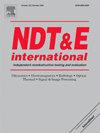基于非线性特征的铆接板损伤定位,利用瞬时基线利用光纤光栅传感器进行导波传感
IF 4.5
2区 材料科学
Q1 MATERIALS SCIENCE, CHARACTERIZATION & TESTING
引用次数: 0
摘要
结构健康监测(SHM)系统是结构安全可靠的保障。它们可以用于维护计划,从而降低维护成本并可能延长使用寿命。因此,在该领域对结构的SHM进行了大量活跃的研究。SHM系统应该是低成本的,适合连续监测,能够检测小水平的损伤。基于导波(GW)的SHM技术允许用几个传感器监测大型板状结构,并且已被确定为最有前途的SHM技术。基于GW的技术面临的挑战之一是,大多数已开发的技术依赖于将当前测量值与已知基线进行比较。通常基线测量是不可用的,或者是在不同的操作条件下获得的。因此,尽管这些技术在实验室测试中表现优异,但在实际应用中适用性并不令人满意。利用非线性特征作为无参考SHM损伤敏感特征的研究已经取得了不同程度的成功。目前的工作建立在利用非线性特征的最初想法的基础上,并将其与瞬时基线方法相结合,开发出一种无参考损伤检测和定位技术。利用适当的时间窗和光纤光栅固有的方向灵敏度,可以很好地检测和定位损伤。为了确定损伤是否存在,提出了一种基于谱能的新度量。通过多频数据融合,进一步增强了度量的鲁棒性。该工作的主要新颖之处在于开发了测量非线性特征的度量和利用光纤光栅传感器。此外,还提出了一种考虑系统非线性的阈值确定方法。该方法应用于铆接在一起的两块铝板。通过移除特定的铆钉来模拟损坏。研究了各种损伤情况,并将该技术的性能与现有的最先进方法进行了比较。本文章由计算机程序翻译,如有差异,请以英文原文为准。
Non-linear feature based damage localization in riveted plates using FBG sensors for guided wave sensing utilizing instantaneous baseline
Structural health monitoring (SHM) systems ensure safety and reliability of structures. They may be used for maintenance planning which reduces the maintenance cost and potentially can extend lifetime. As a result, there is a lot of active research in the area for SHM of structures. The SHM system should be low cost, suitable for continuous monitoring, able to detect small levels of damage. Guided waves (GW) based SHM techniques allow monitoring of large plate-like structures with a few sensors and have been identified as the most promising of techniques for SHM.
One of the challenges of GW based techniques is that most of the developed techniques depend on comparison of the current measurements with a known baseline. Often the baseline measurement is not available or is acquired under different operating conditions. As a result, the applicability of these techniques although excellent in laboratory testing is not satisfactory in real applications. Few works utilizing non-linear features as a damage sensitive feature for reference-free SHM have been proposed with varying degrees of success. The current work builds on this initial idea for utilizing non-linear features and pairs it up with instantaneous baseline approach to develop a technique for reference-free damage detection and localization. Through the utilization of appropriate time windows and the inherent directional sensitivity of the fibre Bragg grating (FBG), it has been shown that damage can be satisfactorily detected and localized. In order to ascertain the presence of damage, a novel metric based on the spectral energy is developed. The robustness of the metric is further enhanced through multi-frequency data fusion. The developed metric and the utilization of FBG sensors for measurement of non-linear features is the main novelty of this work. In addition, a systematic approach for the threshold determination which takes into consideration systematic non-linearities is proposed. The methodology is applied on two aluminium plates riveted together. Damage is simulated through removal of the particular rivet. Various damage scenarios have been studied and the performance of the technique is compared with existing state-of-the art methods.
求助全文
通过发布文献求助,成功后即可免费获取论文全文。
去求助
来源期刊

Ndt & E International
工程技术-材料科学:表征与测试
CiteScore
7.20
自引率
9.50%
发文量
121
审稿时长
55 days
期刊介绍:
NDT&E international publishes peer-reviewed results of original research and development in all categories of the fields of nondestructive testing and evaluation including ultrasonics, electromagnetics, radiography, optical and thermal methods. In addition to traditional NDE topics, the emerging technology area of inspection of civil structures and materials is also emphasized. The journal publishes original papers on research and development of new inspection techniques and methods, as well as on novel and innovative applications of established methods. Papers on NDE sensors and their applications both for inspection and process control, as well as papers describing novel NDE systems for structural health monitoring and their performance in industrial settings are also considered. Other regular features include international news, new equipment and a calendar of forthcoming worldwide meetings. This journal is listed in Current Contents.
 求助内容:
求助内容: 应助结果提醒方式:
应助结果提醒方式:


